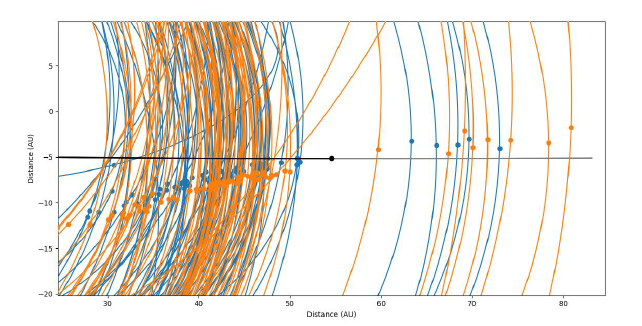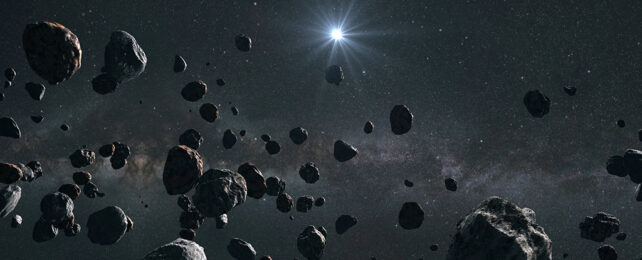A new method for scanning telescope images for the faintest signs of rock far beyond Pluto has uncovered evidence that our Solar System's disc of material extends far further into interstellar space than we thought.
Decades of peering into the shadows have left astronomers with the distinct impression that the diffuse field of icy boulders known as the Kuiper Belt suddenly thins out from 48 times the distance between Earth and the Sun (or 48 AU).
Belts of rubble have been seen extending for at least twice that distance around comparable stars, making our Solar System rather petite by comparison. With this new discovery, we might not be so unusual after all.
A team of astronomers led by Canada's Herzberg Astronomy and Astrophysics Research Centre had hoped to uncover new targets for the New Horizons Probe to investigate as it journeyed through the Solar System's outer reaches.
Having given us a few close-ups of Pluto, the mission snapped pics of a snowman-shaped rock roughly 40 AU from the Sun, before continuing on its merry way at a speed of just under 60,000 kilometers (about 36,000 miles) per hour.
Finding things for the plucky little probe to look at now that it's nearly 60 AU from the Sun is no simple task. To spot anything moving through the perpetual midnight, astronomers need to get clever.
One technique commonly used is called shift-stacking. With such little light at the Solar System's edge, few objects would be visible in any single telescope image.
By taking pictures at different times and then stacking the images on top of one another, it's possible to combine all of that light from a dimly lit object into a point, increasing its visibility.
This is all well and good if the target's path is known. Finding undetected objects this way demands a lot of trial and error, adjusting stacks of images along potential orbits until a glowing gem is revealed.
Even with a computer algorithm to assist, searching for hidden rocks in a shift-stacked pile of hundreds of images requires old-fashioned human power, and a lot of it.
To take at least some of the drudgery out of the process and speed things up, the research team made use of machine learning, training a neural network on made-up objects inserted into telescope imagery before setting it loose on data collected using the Subaru Telescope on Mauna Kea in Hawaii in 2020 and 2021.
Compared with a human search through the 2020 data, the machine learning technique identified twice as many Kuiper Belt Objects, suggesting a distinct rise in the density of material at a distance of around 60 to 80 AU along New Horizons' trajectory.

The results could help explain an anomalous glow detected by both the probe and the Hubble Space Telescope, with the extra debris contributing its own pall of reflective dust in the outer Solar System.
Given similar surveys of other patches of sky have failed to detect such bounties of orbiting objects, it's worth questioning whether they were simply unlucky, if there's something special about the Solar System along New Horizons' path, or if the machine learning technique has a few flaws to iron out.
The study's results are yet to be peer-reviewed, and would then need to be confirmed by future ground- and space-based surveys.
Yet taken at face value, it's possible our Solar System has at least two 'rings' of icy material divided by a gap at around 50 AU; one consisting of the familiar Kuiper Belt, the other a wide stretch of icy boulders reaching as far from Pluto as Pluto is from us.
Why such a gap might exist at all, of course, is an intriguing mystery itself.
This research was presented at the 54th Lunar and Planetary Science Conference 2023.
